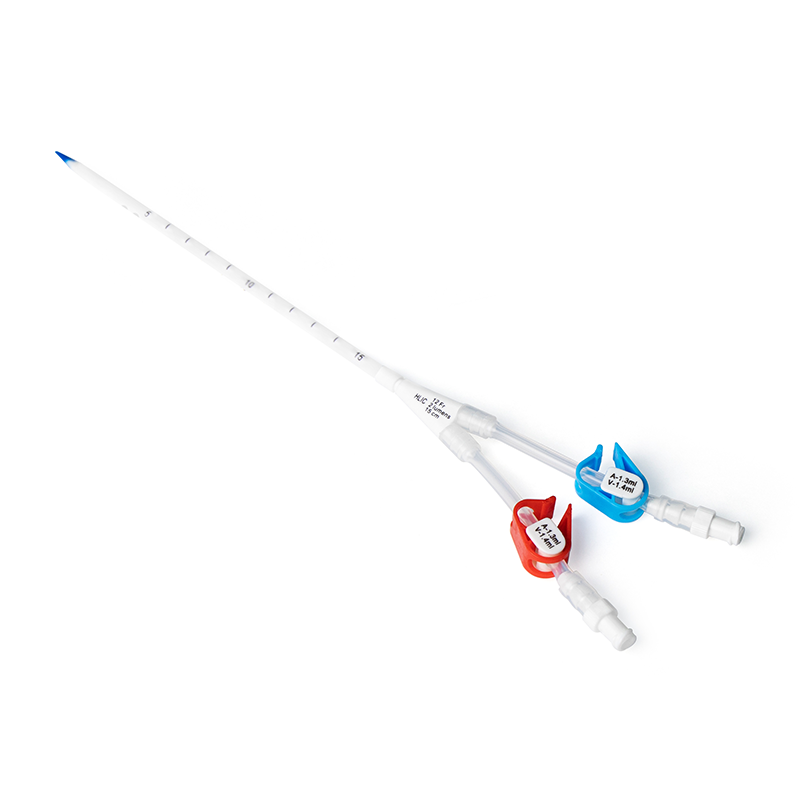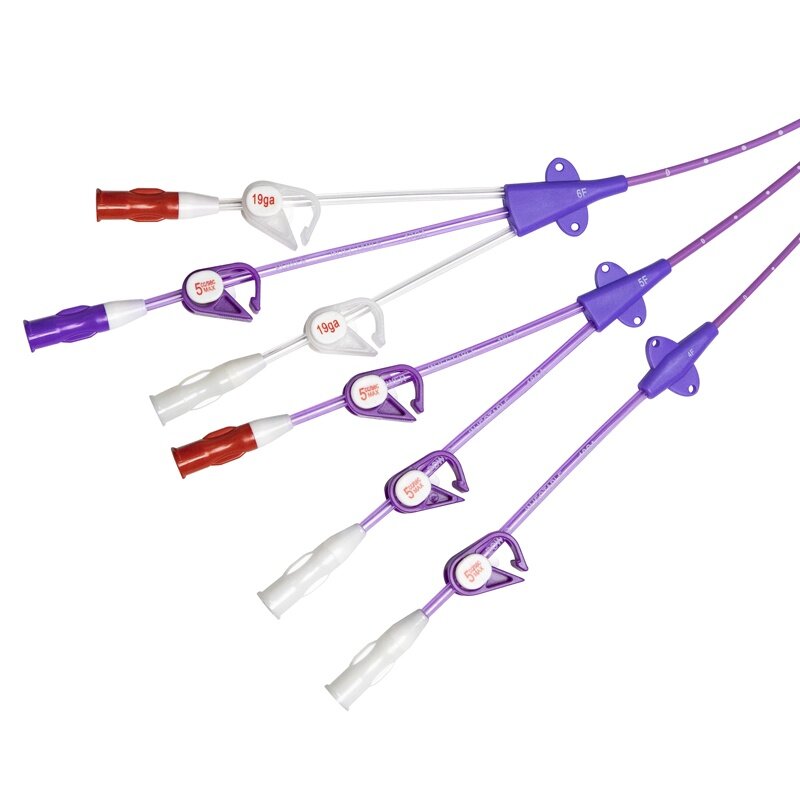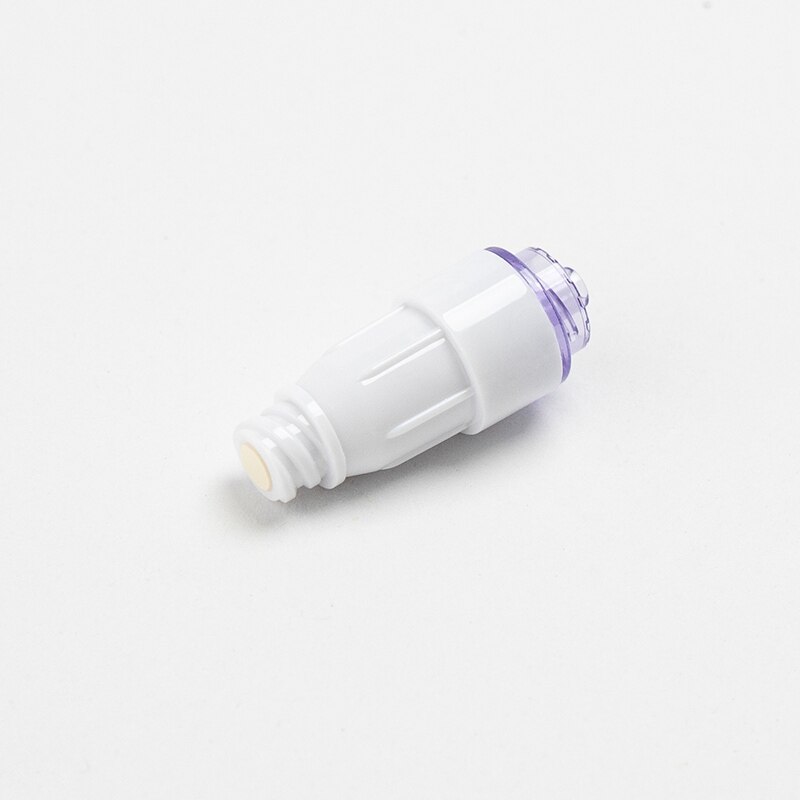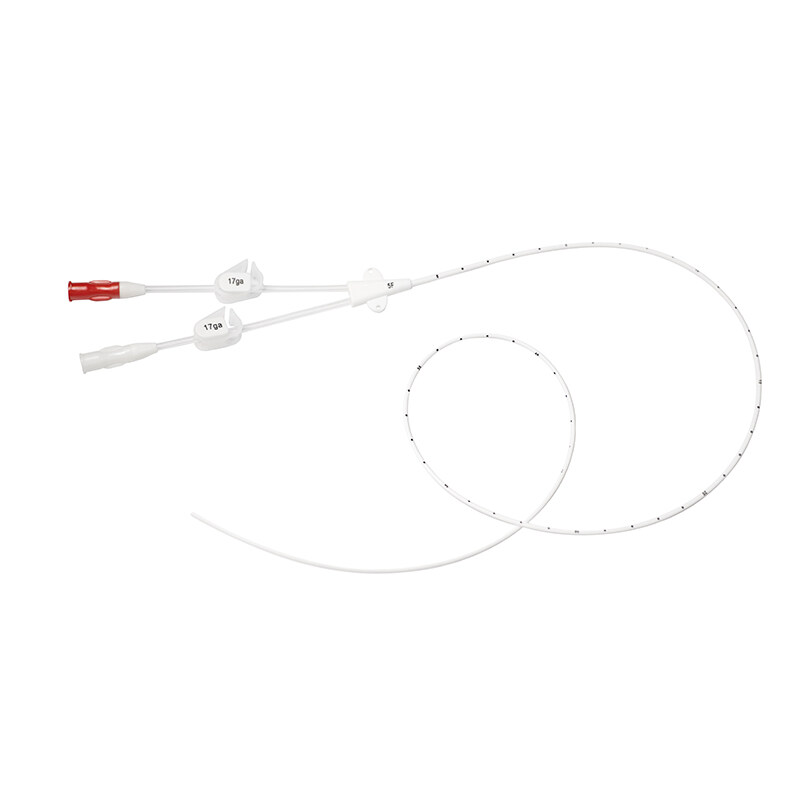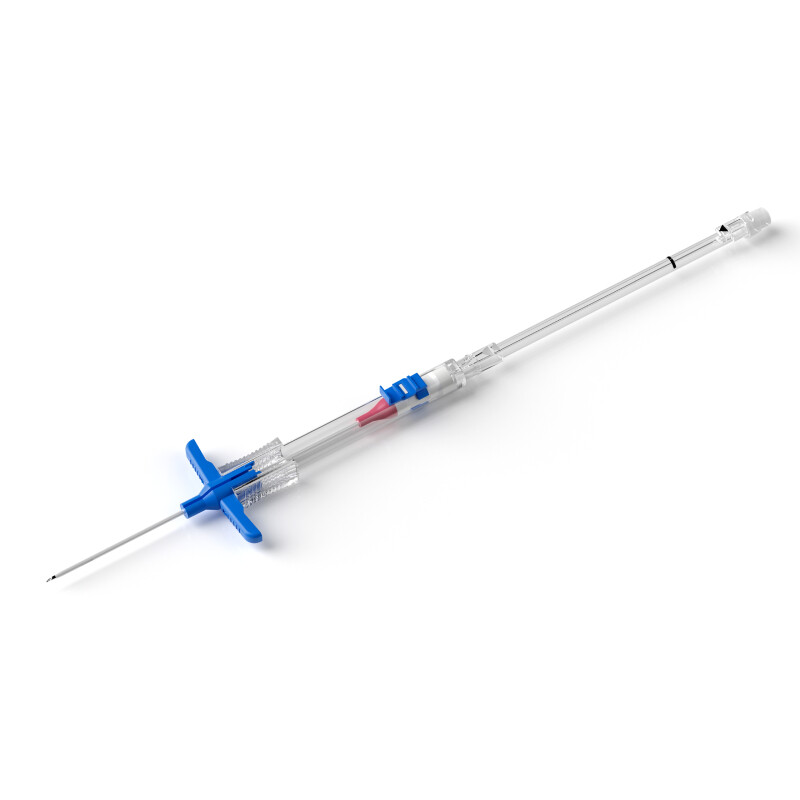Jiamin Luo, Jing Cao, Jiangbo Zhang, Mingyan Li, Taiping Zhu
Abstract
Objective To observe the clinical application effect of umbilical vein catheterization (UVC) followed by peripheral venous insertion of central venous catheter (peripherally inserted central catheter, PICC) in preterm infants.
Methods A retrospective analysis was performed on preterm infants admitted to the author’s department from January 1, 2019 to December 31, 2021 who had central venous catheterization within 4 days after birth. A total of 413 preterm infants were included. The UVC + PICC group consisted of 120 preterm infants who had UVC inserted within 24 hours after birth and then had PICC inserted sequentially after 4 - 10 days of indwelling. The PICC group included 120 preterm infants who only used PICC. The usage of catheters (catheter position, catheter indwelling time, incidence of catheter - related complications, etc.) was analyzed. The PICC group was matched 1:1 with the UVC + PICC group according to preterm infants with umbilical vein catheterization alone who were discharged 4 days after birth, in terms of catheter indwelling time, weight gain, catheter - related bloodstream infection, and neonatal necrotizing enterocolitis (NEC) and other complications during hospitalization. A total of 120 cases were matched. The clinical data of the two groups were compared to analyze the differences in catheter indwelling time, length of hospital stay, weight gain, catheter - related bloodstream infection, and neonatal necrotizing enterocolitis (NEC) and other complications.
Results The average weight gain of the UVC + PICC group during hospitalization was significantly higher than that of the PICC group (P < 0.05). There was no significant difference in the average length of hospital stay between the UVC + PICC group and the PICC group (P > 0.05). The average catheter indwelling time of the UVC + PICC group was significantly longer than that of the PICC group (P < 0.05). There was no significant difference in the incidence of complications such as catheter - related bloodstream infection and neonatal necrotizing enterocolitis between the two groups (P > 0.05).
Conclusion Compared with using PICC alone, the sequential use of UVC and PICC does not increase the incidence of complications such as catheter - related infections and neonatal necrotizing enterocolitis, and the average daily weight gain is better.
Keywords Preterm infant; Umbilical vein catheterization; Peripherally inserted central venous catheter; Complication
In recent years, the success rate of rescuing preterm infants, especially extremely preterm infants, in China has significantly improved. The rational and safe use of venous access is crucial in the treatment of extremely preterm infants. Performing umbilical vein catheterization (UVC) in the early postnatal period is less difficult, which helps to establish a good nutritional status, ensure the positive nitrogen balance of the immature body, and provides a natural venous access. However, there are also related complications during its use, such as pericardial effusion, arrhythmia, extrahepatic complications, and long - term indwelling may increase the risk of catheter - associated bloodstream infection (CRBSI).
Materials and Methods
1. General Information
A retrospective analysis was conducted on preterm infants admitted to the Neonatal Department of the First Affiliated Hospital of Xinjiang Medical University from January 1, 2019 to December 31, 2021 who had central venous catheterization within 4 days after birth. This study was a retrospective analysis, and the informed consent of the infants’ families was obtained.
Inclusion criteria: ① Approved by the hospital’s medical ethics committee and in line with relevant standards; ② Premature infants who needed to use central venous catheters; ③ Gestational age < 32 weeks and/or birth weight < 1500g.
Exclusion criteria: ① Absolute contraindications for UVC or PICC insertion; ② Severe congenital heart disease, gastrointestinal malformation, congenital immunodeficiency diseases within 48 hours after birth; ③ Complicated with skin infectious diseases; ④ Premature infants with central venous catheterization within 4 days after birth but not meeting the inclusion criteria.
Among the 413 enrolled premature infants, 293 premature infants who met the inclusion criteria were selected. 120 premature infants who had UVC inserted within 24 hours after birth and had PICC inserted sequentially after 4 - 10 days of indwelling were selected as the UVC + PICC group; 120 premature infants who only used PICC (catheter position, catheter indwelling time, incidence of catheter - related complications, etc.) after exclusion and matching were selected as the PICC group. The two groups were matched 1:1 according to “gestational age ± 1 week, birth weight ± 100g”, and the UVC + PICC group and the PICC group were matched in terms of related indicators.
2. Related Diagnostic Criteria
(1) Catheter - related bloodstream infection (CRBSI): Diagnosed based on the Guidelines for Prevention and Control of Bloodstream Infections Associated with Vascular Catheters and combined with clinical manifestations (neutropenia, thrombocytopenia, neonatal necrotizing enterocolitis (NEC), etc.).
(2) Bloodstream infection, NEC, and Apgar score: Refer to the 5th edition of Practical Neonatology in China.
(3) Neonatal Simple Severity Score (SNAP - Ⅱ): Assessed 12 hours after birth, including 6 physiological indicators (minimum blood pressure, minimum body temperature, minimum blood glucose pH value, apnea, urine output, and PaO₂/FiO₂ ratio), with a score range of 0 - 115 points.
(4) Phlebitis: Judged according to the relevant standards proposed by the Intravenous Therapy Society, such as redness, swelling, heat, pain at the puncture site, or dark red skin at the puncture site with palpable cord - like induration.
3. Methods
PICC group: Within 4 days after birth, within 10cm to the left of the midline of the clavicle, 1cm below the clavicle, after seeing backflow, insert the catheter, guide the catheter to the corresponding position, pull out the indwelling needle, inject 0.9% sodium chloride solution, and then use X - ray to check the position of the catheter tip.
UVC + PICC group: Insert UVC within 24 hours after birth. After routine disinfection, cut the umbilical cord at 0.5 - 1.0cm, insert the catheter into the umbilical vein, suture and ligate the remaining end, fix it with an umbilical cord circumferential fixation device, check the position of the umbilical vein catheter by X - ray, and start using it after the position is correct. The tip of the catheter is 0.5 - 1.0cm above the diaphragm as the central vein; if it is not the central vein, withdraw and retain 4 - 5cm as the peripheral vein. Replace with PICC step - by - step 4 - 10 days after indwelling. The above operations are completed by doctors or nurses with relevant qualifications.
4. Observation Indicators
(1) Treatment effect: Discharge weight, average length of hospital stay, average daily weight growth rate.
(2) Complications: Incidence of catheter - related infection, NEC, omphalocele, phlebitis.
5. Statistical Methods
SPSS 22.0 statistical software was used for data analysis. Measurement data were expressed as mean ± standard deviation (\bar{x}\pm s), and the comparison between groups used the t - test. Count data were expressed as number of cases (percentage) [n(%)], and the comparison between groups used the \chi^{2} test. A difference with P < 0.05 was considered statistically significant.
Results
1. Basic Information of the Two Groups of Preterm Infants
The basic information of 120 preterm infants in the UVC + PICC group and 120 preterm infants in the PICC group: The average birth weight of the UVC + PICC group was 1291.00 ± 220.33g, and the average gestational age was 30.06 ± 1.56 weeks; the average birth weight of the PICC group was 1300.00 ± 184.97g, and the average gestational age was 30.27 ± 0.99 weeks. There was no statistically significant difference in gestational age, birth weight, neonatal condition, neonatal disease severity score between the two groups of preterm infants (P > 0.05). The general data of the two groups of preterm infants were comparable (see Table 1).
Table 1 Basic Information of the Two Groups of Preterm Infants [n(%),  ± s]
± s]
|
Item
|
UVC + PICC Group (n = 120)
|
PICC Group (n = 120)
|

|
P
|
|
Gestational age (weeks)
|
30.06 ± 1.56
|
30.27 ± 0.99
|
1.07
|
0.28
|
|
Birth weight (g)
|
1291.00 ± 220.33
|
1300.00 ± 184.97
|
0.60
|
0.42
|
|
Apgar score at 5 minutes
|
10(8.3)
|
8(6.6)
|
0.24
|
0.62
|
|
SNAP - Ⅱ score ≥ 20 points
|
21(17.6)
|
19(15.8)
|
0.57
|
0.45
|
|
Neonatal asphyxia
|
12(10.0)
|
11(9.1)
|
0.20
|
0.65
|
Note: - Fisher’s exact test was used, and no exact data were obtained. SNAP - Ⅱ: Neonatal Simple Severity Score
2. Comparison of Weight Gain and Length of Hospital Stay between the Two Groups of Preterm Infants
Compared with the PICC group, the average discharge weight and average weight gain of the UVC + PICC group were significantly increased, and the difference between the two groups was statistically significant (P < 0.05). There was no statistically significant difference in the average length of hospital stay between the UVC + PICC group and the PICC group (P > 0.05) (see Table 2).
Table 2 Comparison of Weight Gain and Length of Hospital Stay between the Two Groups of Preterm Infants ( ± s )
± s )
|
Item
|
UVC + PICC Group (n = 120)
|
PICC Group (n = 120)
|
t
|
P
|
|
Average length of hospital stay (days)
|
29.40 ± 13.49
|
28.86 ± 10.62
|
0.28
|
0.77
|
|
Average daily weight gain (g)
|
1738.10 ± 123.89
|
1684.56 ± 139.76
|
2.30
|
0.02
|
|
Average weight gain during hospitalization (g·d⁻¹)
|
13.14 ± 3.88
|
9.41 ± 5.39
|
2.12
|
0.03
|
3. Catheter Indwelling of the Two Groups of Preterm Infants
UVC + PICC group: There were 120 cases, including 2 cases of pericardial effusion, 1 case of impaired liver function, 6 cases of clinically suspected CRBSI, 13 cases of confirmed CRBSI with unplanned catheter removal, and 98 cases reached the predetermined clinical endpoints, accounting for 81.6%.
PICC group: There were 120 cases, including 2 cases reaching the endpoint, 6 cases of omphalocele, 8 cases of suspected CRBSI, 7 cases of confirmed CRBSI with unplanned catheter removal, and 105 cases reached the predetermined endpoints, accounting for 87.5%.
4. Comparison of Catheter - related Complications in the Two Groups of Preterm Infants
The total indwelling time, average indwelling time, and incidence of complications of the two groups of preterm infants: The total indwelling time of 120 cases in the UVC + PICC group was 2620 days, the average indwelling time was 21.79 ± 8.05 days, the incidence of omphalocele was 16 cases (13.3%), the incidence of NEC was 13 cases (10.8%), the incidence of bloodstream infection was 3 cases (2.5%), the incidence of phlebitis was 2 cases (1.7%), and the incidence of CRBSI was 15 cases (12.5%), with an average of 5.5 cases/1000 catheter days, and the average number of CRBSI was 17 times, with an average of 6.48 times/1000 catheter days. The total indwelling time of 120 cases in the PICC group was 2076 days, the average indwelling time was 17.30 ± 8.58 days, the incidence of omphalocele was 6 cases (5.0%), the incidence of NEC was 5 cases (4.2%), the incidence of bloodstream infection was 4 cases (3.3%), the incidence of phlebitis was 5 cases (4.1%), and the incidence of CRBSI was 8 cases (6.7%), with an average of 3.8 cases/1000 catheter days, and the average number of CRBSI was 10 times, with an average of 4.81 times/1000 catheter days. The average indwelling time of the catheters in the two groups showed that the indwelling time of the UVC + PICC group was longer than that of the PICC group (P < 0.05). The incidence of omphalocele, NEC, and CRBSI in the UVC + PICC group was slightly higher than that in the PICC group, but the difference was not statistically significant (P > 0.05).
5. Relationship between UVC + PICC Group and UVC Indwelling Time and Complications
The relationship between UVC indwelling time and complications in 120 cases of the UVC + PICC group: There were 82 cases in the UVC + PICC group with UVC indwelling time ≤ 7 days, 38 cases with indwelling time > 7 days, 9 cases with omphalocele in 82 cases with indwelling time ≤ 7 days, 7 cases with NEC, and 4 cases with CRBSI; 7 cases with omphalocele in 38 cases with indwelling time > 7 days, 6 cases with NEC, and 4 cases with CRBSI. The incidence of omphalocele, NEC, bloodstream infection, and catheter - related bloodstream infection between the two groups was compared, and the difference was not statistically significant (P > 0.05).
6. Relationship between UVC + PICC Group and UVC Position and Indwelling Time
The relationship between UVC position and indwelling time in 120 cases of the UVC + PICC group: There were 48 cases of standard - position UVC and 72 cases of low - position UVC. The average indwelling time of standard - position UVC (8.11 ± 2.69 days vs 4.35 ± 1.29 days) was significantly longer, and the incidence of omphalocele in standard - position UVC was 3 cases (4.1%), and the incidence of omphalocele in low - position UVC was 13 cases (27%), and the incidence of standard - position UVC omphalocele was significantly lower than that of low - position UVC, with a statistically significant difference (P < 0.05). There was no statistically significant difference in the incidence of NEC and catheter - related infection between the two groups (P > 0.05).
Discussion
The survival and living conditions of preterm infants have received extensive attention. Because their gastrointestinal function is not yet fully developed, they often require long-term intravenous infusion of nutrients and antibiotics. Peripherally inserted central catheter (PICC) addresses this need. Umbilical vein catheterization (UVC) is relatively soft in the early stage, and the operation of inserting the catheter through the umbilical blood vessel is relatively easy, so it can serve as an early-stage venous access. In a study by Butler et al., for preterm infants with a birth weight < 1251 g, a random trial of long-term and short-term use of umbilical vein catheterization found that the incidence of catheter-related bloodstream infection (CRBSI) was slightly higher when the UVC indwelling time exceeded 7 days. Therefore, it is recommended to routinely remove the UVC 7 days after indwelling and insert a PICC, which helps reduce the occurrence of CRBSI. This combined approach has become a commonly used venous access method for preterm infants in China. UVC followed by PICC provides a safe and effective central venous access for preterm infants, meeting their nutritional needs in the early postnatal period, and this solution is more economical. This study explores the clinical effects of UVC sequential PICC and single PICC in preterm infants in our department to guide the rational use of central venous catheters in clinical management.
Among the 120 cases in the UVC + PICC group that met the research criteria, all catheters were successfully inserted, and the unplanned catheter removal rate was 18.4%. The unplanned catheter removal rate of the 120 cases in the PICC group was 12.5%. Luo Jiamin et al. reported an unplanned catheter removal rate of 6.25%, and the unplanned catheter removal rate in this study was relatively high. The maintenance of PICC catheters needs to be improved to reduce the occurrence of unplanned catheter removal. Strengthen hand hygiene training for PICC nursing staff during PICC use, enhance the PICC catheter indwelling process, and improve the PICC catheterization rate. Promote standardized and normalized nursing to reduce central venous infections in newborns. In the study of bacterial culture at the end of the catheter, there were 15 cases of positive blood culture and 3 cases of negative blood culture in the UVC + PICC group, and 10 cases of positive blood culture and 4 cases of negative blood culture in the PICC group. The UVC + PICC group had a higher rate than the PICC group. Considering that the indwelling time of UVC + PICC may increase the risk of infection, but the difference was not statistically significant.
In extremely preterm infants, especially extremely low-birth-weight infants, extrauterine growth and development are often slow. Maintaining a stable fluid balance and acid-base balance in the early postnatal period and providing timely nutritional support to the body are of great significance for the growth and development of extremely preterm infants. The osmotic pressure requirement for fluid infusion through peripheral veins is limited to 0.3 - 0.9 Osmol/L. Although peripheral vein infusion can meet the needs of fluid infusion in the early stage after birth, central vein infusion can be used when the infant's condition is stable after birth. After umbilical vein catheterization provides nutritional support, the central vein can reach 25%, which can provide sufficient venous nutrition, and the indwelling time of the umbilical vein catheter can be extended to meet the needs of the infant's growth and development. Butler et al. found in a study of umbilical vein catheterization in preterm infants that the incidence of CRBSI was lower in those with an indwelling time ≤ 7 days, and it is recommended to routinely remove the UVC 7 days after indwelling and insert a PICC.
The 120 cases in the UVC + PICC group in this study had an average indwelling time of 21.79 ± 8.05 days, which was longer than the indwelling time in the PICC group, and the average weight gain was higher than that in the PICC group, with a statistically significant difference (P < 0.05). The average length of hospital stay in the UVC + PICC group was longer than that in the PICC group, but the difference was not statistically significant (P > 0.05). The possible reasons are that the UVC + PICC group in this study included extremely low-birth-weight infants and very low-birth-weight infants with a gestational age < 32 weeks, and the three-level diagnosis and treatment of infants with a gestational age < 32 weeks and a birth weight < 1500 g is relatively stable, and they are transferred to a lower-level hospital for continuous diagnosis and treatment, so there is little difference in the number of hospital days.
The combination of UVC and PICC has a good effect, which can effectively extend the indwelling time of central vein catheters in preterm infants, reduce the occurrence of catheter-related adverse events. In a study of 139 cases of UVC combined with PICC in extremely low-birth-weight infants with a gestational age < 32 weeks and a birth weight < 1500 g, it was found that the combined catheterization can greatly reduce the number of punctures, and the number of hospital days is relatively reduced. In cases of sepsis, feeding intolerance, NEC, etc., there was no statistical significance in the comparison between the UVC + PICC group and the PICC group. The incidence of omphalocele, NEC, and CRBSI in the UVC + PICC group was higher than that in the PICC group, but the difference was not statistically significant. The use of UVC not only can meet the early energy supply of preterm infants, ensure the growth and development needs of preterm infants, but also UVC is easier to operate in the early stage, which can reduce the indwelling time of PICC and related infections, and reduce the occurrence of PICC-related complications.
The optimal position for UVC indwelling after insertion is at the junction of the right atrium and the inferior vena cava. X-ray positioning shows that the tip of the catheter is at the level of the xiphoid process or below the diaphragm. When the tip of the catheter is at the 9th - 10th thoracic vertebra or the 8th - 9th lumbar vertebra (that is, the tip of the catheter is outside the heart), if the tip of the catheter needs to be adjusted to the inferior vena cava, the "low position" of inserting about 5 cm to the left of the midline of the clavicle should be used. A domestic study in 2019 found that the incidence of CRBSI was lower when the UVC indwelling time was ≤ 7 days, so it is recommended to remove the UVC after 7 days of indwelling. The indwelling time of UVC in this study is relatively long, and the incidence of CRBSI is also relatively high.
A foreign study in 2011 also confirmed that the incidence of CRBSI was higher when the UVC indwelling time was longer. Among 641 cases of UVC, 31.9% had malposition, and the incidence of CRBSI was higher when the UVC was malpositioned (4.0 ± 2.6 days vs 6.1 ± 2.6 days, P < 0.01). Considering "low-position" UVC is prone to complications such as blood vessel injury, leakage, catheter blockage, and thrombosis. UVC may damage the intestinal mucosa, leading to NEC, or cause intestinal mucosal ischemia and necrosis, leading to perforation. After UVC is removed, it may also reduce the diversity of intestinal flora in preterm infants, reduce the production of beneficial bacteria, which is not conducive to the growth of multiple intestinal flora. In the diagnosis and treatment of omphalocele, the position of the catheter and improper catheter position are the main factors affecting the occurrence of omphalocele after UVC.
In a study of 974 cases of umbilical vein catheterization in newborns, 120 cases in the UVC + PICC group had no omphalocele, feeding intolerance, etc. The average indwelling time of UVC in the UVC + PICC group was 8.11 ± 2.69 days, which was longer than that of low-position UVC (4.35 ± 1.29 days). The incidence of omphalocele in standard-position UVC was significantly lower than that in low-position UVC, with a statistically significant difference (P < 0.05). There was no statistically significant difference in the incidence of NEC and CRBSI between the two groups.
In conclusion, compared with using PICC alone, the sequential use of UVC and PICC does not increase the incidence of complications such as catheter-related infections and neonatal necrotizing enterocolitis, and the average daily weight gain is better. UVC sequential PICC can meet the nutritional needs of preterm infants, effectively improve safety, reduce the incidence of complications, and improve the weight gain rate of infants. It is worthy of wide application in clinical practice.
References
[1] Yin B, Huang W, Li X, et al. Retrospective analysis of 13 - 171 cases of extremely low - birth - weight and very low - birth - weight infants from 2007 to 2016 [J]. Chin J Pediatr, 2019, 57(2): 13 - 17.
[2] Lu J, Xi J, Zhou B, et al. Analysis of umbilical vein catheterization in extremely low - birth - weight infants [J]. Chin J Neonatol, 2018, 33(5): 380 - 382.
[3] Deng X, Zhong M, Li X, et al. Research progress on indications and time of indwelling of umbilical vein catheters [J]. Chin J Perinat Med, 2021, 24(6): 471 - 475.
[4] O’Meara AP, Alexander M, Burns LA, et al. Guidelines for the prevention of intravascular catheter - related infections [J]. Clin Infect Dis, 2011, 52(9): e162 - e193.
[5] Milstone AM, Reich NC, Abrams S, et al. Catheter dwell time and CLABSI in neonates with PICCs: a multicenter cohort study [J]. Pediatr Infect Dis J, 2013, 32(6): 609 - 615.
[6] Guidelines for Prevention and Control of Vascular Catheter - related Infections (2021 Edition) [J]. Infect Dis Inform, 2021, 34(4): 289 - 290, 198.
[7] Shao XM, Ye HM, Qiu XS. Practical Neonatology (5th Edition) [M]. Beijing: People’s Medical Publishing House, 2019.
[14] Chen Y, Chen Y, Cao P, et al. Faecalibacterium prausnitzii facilitates ulcerative colitis through activating E - 17 signaling to NF - κB via the upregulation of CARD9 expression [J]. J Pathol, 2020, 252(4): 170 - 182.
[15] Ralston MR, Wang X, Liu W, et al. Faecalibacterium prausnitzii promotes epithelial carcinogenesis by modulating E - cadherin/β - catenin signaling via FoxA2 in mice [J]. Cell Host & Microbe, 2013, 14(2): 195 - 206.
[16] Roustazadeh S, Akbari HA, Dabiri H, et al. The association between Helicobacter pylori and different types of colorectal polyps: a systematic review and meta - analysis [J]. Microb Pathog, 2021, 152: 243 - 249.
[8] Roberton SL, Simpson JM, Hopper SR, et al. SNAP - Ⅱ for prediction of mortality and morbidity in extremely preterm infants [J]. J Matern Fetal Neonatal Med, 2009, 22(16): 2064 - 2070.
[9] Chen K. Risk factors for infectious complications in neonates with UVC in 2019 [J]. Chin J Perinat Med, 2021, 24(11): 773 - 779.
[10] Li S, Wei Y, Zhang Y, et al. Risk factors for neonatal necrotizing enterocolitis in 2017 [J]. Chin J Neonatol, 2019, 34(2): 204 - 209.
[11] Butler M, Drazgal CJ, Henry H, et al. An evidence - based catheter bundle to decrease central venous catheter - related bloodstream infection [J]. J Pediatr, 2012, 160(6): 972 - 977.
[12] Zhu W. Effect of sequential UVC and PICC in extremely low - birth - weight infants [J]. J Nurs Admin, 2022, 37(4): 289 - 293.
[13] Luo L. Effect of quality improvement on unplanned removal of PICC in low - birth - weight infants [J]. Chin J Med Instrum, 2021, 11(7): 148 - 150, 179.
[14] Deng B, Yang X, Liu X, et al. Guidelines for umbilical vein catheterization in neonates (2022 Edition) [J]. Chin J Neonatol, 2022, 37(1): 7 - 11.
[15] Li X. Neonatal Infusion Therapy [M]. Beijing: Chemical Industry Press, 2013.
[16] Liu X, Zhu B. Application of umbilical vein catheterization in preterm infants [J]. Chin J Matern Child Health Care, 2022, 37(7): 1254 - 1256.
[17] Fang Y, Li B. Application of umbilical vein catheterization combined with PICC in extremely low - birth - weight infants [J]. J Nurs Admin, 2022, 37(12): 1254 - 1256.
[18] Zhou Y, Yin J, Li S, et al. Application of PICC in extremely low - birth - weight infants [J]. Chin J Neonatol, 2021, 36(5): 350 - 354.
[19] Subspecialty Group of Neonatology, Chinese Society of Pediatrics, National Center for Children’s Health, et al. Guidelines for prevention and control of central venous catheter - related infections in neonates [J]. Chin J Neonatol, 2021, 36(1): 1 - 9.
[20] Chen Q, Yang M, Liao X, et al. Research progress on the safety of umbilical vein catheterization [J]. Chin J Perinat Med, 2019, 22(1): 51 - 54.
[21] El - Nahas N, Cleassens C, Lanser T, et al. Central venous prac - tices and umbilical catheters: a multicenter study of low - birth - weight neonates [J]. Am J Perinatol, 2019, 36(11): 1199 - 1204.
[22] Deng M, Tan X, An J, et al. Risk factors for umbilical vein catheter - related complications [J]. Chin J Obstet Gynecol, 2022, 57(2): 136 - 141.
[23] Sun D, Wang J, Yang Q, et al. Effect of umbilical vein catheterization on intestinal flora in preterm infants [J]. Chin J Perinat Med, 2021, 24(5): 350 - 354.
[24] Yang X, Sun L, Wang J. Research progress on factors affecting the prognosis of umbilical vein catheterization [J]. J Mod Med Health Res (Electronic), 2019, 3(24): 13 - 15.

